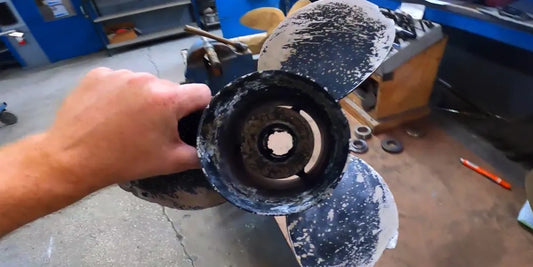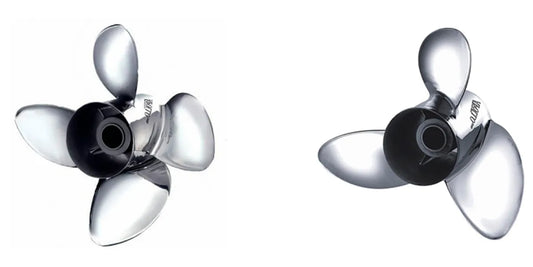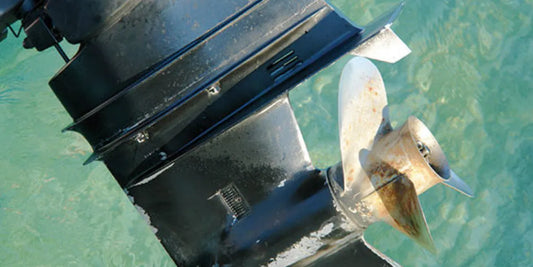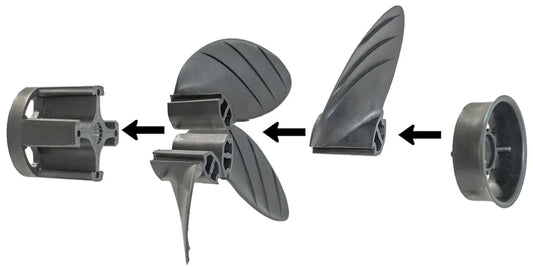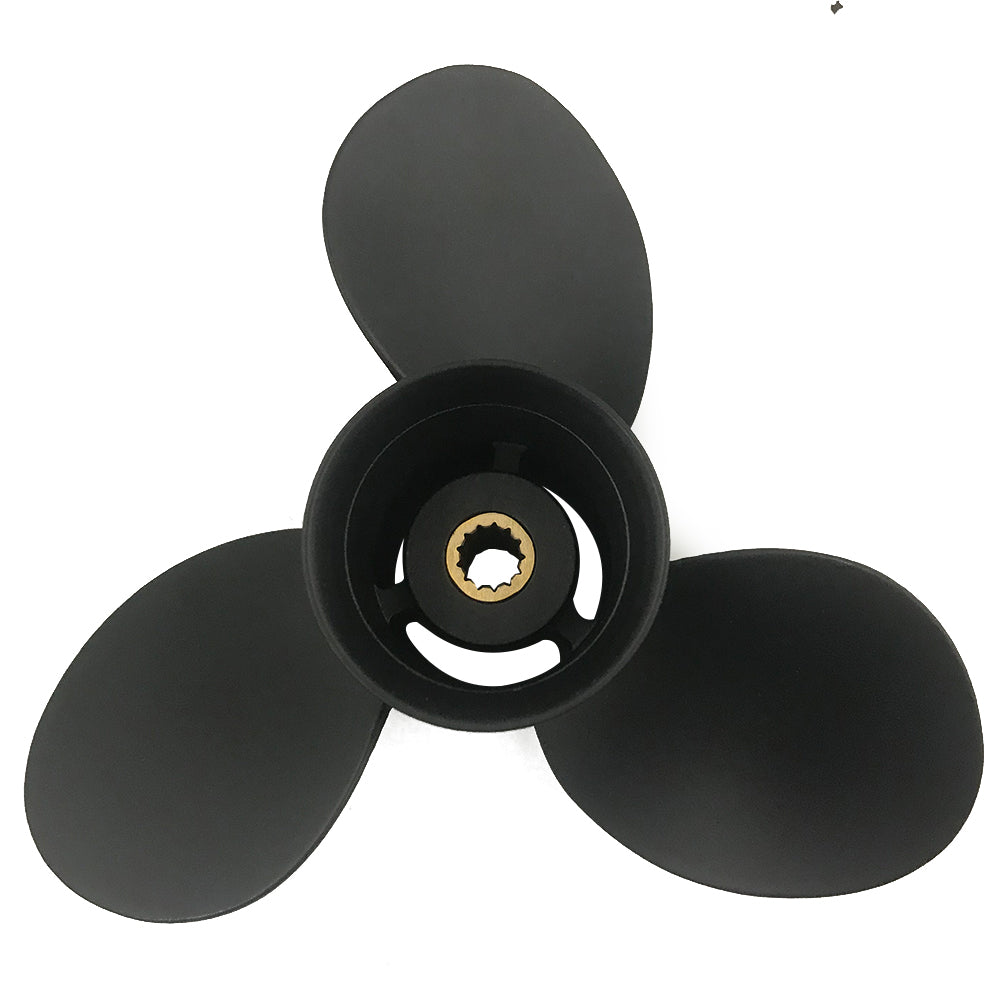Are you interested in having your boat perform at a slightly higher standard and enjoying smoother, quicker disembarkations onto a lake? Propeller design might just be the big secret. Knowing what a cupped propeller is and its benefits would open up possibilities for greater vigor, speed, and control of your boat. This article considers the whole cupped propeller science and workings, whether you're fully knowledgeable in boating or just a curious beginner. It examines how this concept works to improve performance by reducing slip and increasing bite in water. So much will change for the better in your boating journey with such key tips and tricks for selecting and optimizing the right propeller for your needs!
What is a cupped propeller, and how does it work?

Understanding the propeller design
A cupped propeller is an engineering wonder crafted to enhance boat performance by reducing propeller slip and promoting efficiency. The design of a cupped propeller contains a small curved lip on the trailing edge of the blade. This minute addition works in unison with the blade's entire geometry to enhance hydrodynamic flow and ensure better grip.
In operation, the cup changes how water interacts with the blades. It propels the vehicle better by redirecting water flow, reducing turbulence, and reducing energy waste. More so, cupped propellers work better at top speeds, thus stopping cavitation from setting in. Cavitation is the formation and sudden collapse of vapor bubbles, which can cause severe damage and performance detriment if they exist for too long. Marine data has found that boats with cupped propellers enjoy better fuel economy, monster top-end speeds, and higher handling abilities.
These technical advantages make cupped propellers suitable for various applications, from leisure crafts to high-performance racing and commercial purposes. By knowing this complex design, the boater can make better decisions when selecting the best propeller for his craft.
Role of the propeller cup in efficiency
The propeller cup becomes essential in counteracting the resultant forces of resistance acting upon a propeller and thus can maximize the efficiency of the operation. It constitutes a slight curve or lip at the tip of the trailing edge of the cup blade, working to enhance water holding by the vessel and not losing whatever thrust is created through slippage. That said, being a cup in propellers will provide, among other advantages, an improved fuel economy as it fulfills the required thrust with lower resistance on its propulsion engine.
In addition, a cupped propeller will achieve even better results at high speeds, thus making its water holding ability and anti-cavitation measures much more pronounced. This results in smoother acceleration and more control when it matters most, whether rough waters or tight corners. Furthermore, through various research and practical marine engineering applications, these rates of efficiency gains are found to change with the variation of angle and depth of the cup, allowing the feature to be developed precisely for particular boating requirements.
Differences between a cupped propeller and a standard propeller
Everything that cupped propellers are, and everything that standard propellers are. They stand at counterpoints in design and performance, and are thus chosen differently for differing applications. The cupped nature of the propeller comes from the slight upward curve, or cup, found on the trailing edges of the blades. This subtle change maximizes grip on the water, reducing slippage and empowering the propeller to provide more thrust. This makes the cupped propeller excellent for high-performance boating applications, wherein acceleration is enhanced due to lower drag, top speed gains from improved water flow, and fuel economy is considered in drag reduction.
Standard propellers, on the other hand, usually have flatter blade surfaces without curvature. This design suffices for general boating but may lose out on the performance advantages that would be ripe under demanding conditions for a cupped propeller. Standard propellers cater to the simplicity and all-around capability, working in medium conditions wherein extra grip or load benefits are not required.
Most performance data show that cupped propellers could reduce cavitation, increasing boat speed from 3-5%, depending on blade pitch and engine power ratings. Stabilizing a higher performance-state while cruising in the middle to the highest speed range makes the cupped propeller popular among more aggressive speedsters or those who mate with rough water upkeep. Standard propellers are a cheap classic option with acceptable performance for recreational boating on gentler waters. The distinction depicts the necessity of evaluating which application is associated with different propellers for the best outcome.
How does a cupped propeller improve speed and performance?

Impact on propeller pitch and RPM
Cupping often affects pitch as well as RPM for engine-propelled water vehicles. From this point of view, adding cupping is a theoretical means of effectively increasing a propeller's pitch without altering the blade's original design. Hence, at each revolution, the propeller can exert more thrust on the water in the forward direction, thus working better at higher speeds.
With the increase in compelling pitch, the engine RPM generally decreases since the engine finds it harder to turn a cupped propeller than a normal one. This low RPM results in fuel efficiency and less wear on the engine while in use. Cupping is a fun promoter for acceleration, ensuring that slippage does not set in, which usually occurs at high speeds or during adverse water conditions.
This means that an uncupped or standard propeller running at 4,500 RPM stands the chance of dropping to about 4,300 RPM as soon as an equidimensioned cupped propeller is rigged on the boat. Notwithstanding the reduction in RPM, the cupped propeller usually increases boat speed by imparting optimum thrust and least drag on the hull. A proper cup selection can make the propeller respect a fine balance between speed, control, and engine efficiency, keeping it adaptable to several maritime applications.
Reducing cavitation with a cupped prop
Cavitation has, in fact, been the most common element in propulsion systems, affecting performance adversely by degrading efficiency, creating noise, and damaging the propeller over time. A cupped propeller faces this problem better and mitigates the risk of cavitation. The unique cupped blade design increases the blade's bite into the water and thus reduces the chance of air bubbles forming around the propeller blades at high speed or heavy load. This tighter bite helps retain pressure levels and avoids cavitation, allowing smooth and consistent propulsion.
However, a cupped design is most effective in situations requiring higher trim angles or greater speed, which it produces by stopping water from slipping off the blades. In short, by modifying water flow and decreasing turbulence in operation, the cup improves displacement and optimizes thrust. Comparative studies show that boats with cupped propellers generally registered far lower cavitation levels during high-performance tests, with some models noted for as much as a 10-15% overall improvement in cavitation resistance.
Also, newer developments in cupped prop technology provide numerous options tailored for different performance requirements. The operator of a boat can thus choose props of differing degrees of cupping that best match the particular needs of his vessel, for example, to enhance acceleration for a recreational boat or to increase load-carrying capabilities for a workboat. This versatility, coupled with the real reduction in cavitation-winning cupped propellers, should firmly support them as the best answer for efficient and durable marine propulsion.
Enhancing propeller performance with cupped propellers
This unique propulsion solution creates a perfect performance around a slight curl or curve along the trailing edge of the propeller blade. This ingenious adjustment in the design allows the propeller to improve its grip on the water, losing less slippage and generating more thrust. Tests have shown an increase of up to 10% in efficiency with cupping, depending on the particular use and amount of cupping. Another benefit of this alteration is that it changes the flow along blade surfaces in such a way as to reduce cavitation; cavitation is one of the most significant problems since it causes noise and vibrations and can sometimes lead to the deterioration of the propeller.
This allows cupped propellers with a larger pitch on high-speed boats to be installed without detriment to engine performance, which translates to higher top-end speed or better fuel efficiency. On the other hand, slow and heavy vessels attain more pulling power and less engine stress. This will allow cupped propellers to be among the most well-rounded choices across the maritime spectrum, enhancing appropriate recreational and commercial implementation.
Choosing the right cupped propeller for your boat

Factors to consider when buying a new prop
Material: The propeller's material naturally affects its performance, potential durability, and cost. Aluminum propellers remain light and cheap, making them an option for the average boater, while a stainless steel one is considered higher performance and will naturally cost much more. Therefore, considering the options for a composite or plastic propeller would be another choice for corrosion-resistant functionality operating in shallow-water applications.
Pitch and Diameter: These are the two major dimensions that govern thrust and speed. Higher pitch is best for increased speed; however, lower pitch suits acceleration and towing. Diameter, which refers to overall size, needs to be proportional. Making sure that a propeller corresponds to the power output of your engine is the best way to ensure efficiency. Check your boat's manual or talk to a marine technician to ensure you get the right size.
Number of Blades and Design: Often, the regular four-blade propeller accents dark, smoothness, control, and acceleration with very few drawbacks, or it may be left with three, just for maximum top-end speed. Blade shape will affect angle water resistance and possibly the blade's efficiency, with common designs forming cupped or raked blades, depending on whether they are aimed at reducing slippage or increasing grip in rough water.
Engine Type and Boat Use: The propeller specifications will change depending on whether you have an outboard, inboard, or sterndrive engine. The design of the boat itself also matters. For instance, the prop might have to generate maximum initial thrust for a water skiing boat, whereas a fishing boat might require a prop design that favors constant high torque at low speeds.
Adjusting for Performance: Aftermarket modifications can almost match the function of your prop as near as your heart desires, i.e., cupping or boosting, if you do a great deal of towing. Also, think about your load; custom prop choices can also optimize water and cruising conditions. Learning more about the recent advances in prop design- whether hybrid, high thrust, etc.- may be helpful when pursuing a particular goal.
With these points considered with extra care, you can pick the exact propeller fitting your boat, putting it to work for maximum performance and longevity in the water.
Comparing Michigan Wheel and Michigan Match propellers
There are two famous names in the world of propeller design, both providing qualities to meet different boating needs: Michigan Wheel and Michigan Match. Michigan Wheel propellers are renowned for their craftsmanship and flexibility, with precision materials, generally stainless steel or aluminum. These propellers find applications across the board, from recreational boating to heavy-duty commercial vessels, focusing on innovation and durability. Michigan Wheel propellers are designed with the latest hydrodynamic principles to ensure high efficiency, low fuel consumption, and better thrust performance.
On the other hand, Michigan Match propellers are an economical, practical choice for recreational boat owners. They are mostly aluminum-based and have a more standardized design with excellent performance for general boating conditions. The Michigan Match series is a household word among casual boaters who want a dependable, readily replaceable option without compromising functionality. Plentiful propellers translate into solid acceleration and balanced handling, perfect for light to moderate-duty applications.
Both guarantee quality and engineering know-how. Still, the ultimate choice largely depends on your specific boating needs: Michigan Wheel is the top choice when considering performance or customs. The Michigan Match embraces affordability for everyday applications without compromising dependability or success.
Evaluating 3-blade vs. other propeller designs
When selecting the right propeller design, the number of blades is critical to the vessel's performance. Three-blade propellers are generally accepted in the industry as they offer a balanced combination of speed, thrust, and fuel economy. The design of these blades is streamlined to reduce drag further and increase top speed compared to those with more blades. So, this makes them ideal for recreational boating, water sports, and light commercial use.
However, other designs, such as the four- and five-blade configurations, offer specific advantages in certain conditions. For example, four-blade propellers are preferred spectrally for stability and smooth running, as they generate lower vibration levels and guarantee steadier handling in rough waters. They also serve applications demanding low-speed handling better, such as fishing or towing wakeboarders.
Conversely, five-blade propellers prioritize utility most of all, providing even greater thrust and smoothness of operation while compromising a bit higher fuel consumption and slightly lower top speeds; these are used in high-performance crafts that require very fast acceleration and the capacity to carry loads.
At the end of the day, one chooses between a 3-blade and another design depending on how the vessel intends to utilize it, engine performance, and operating conditions. Three-blade propellers are the right choice for most users, yet others are worth venturing into when special requirements such as heavy load, high performance, or low vibration are needed. Knowing this blade design will ensure you make a good choice towards more efficiency and longevity of your setup.
How do you maintain and repair a cupped propeller?

Regular propeller repair and maintenance tips
Proper maintenance practices on a cup propeller allow it to perform optimally, extending its lifetime. Start inspecting the propeller regularly for signs of wear, as cracks, dents, or bent blades, as these may severely reduce its efficiency and increase fuel consumption. Clear all debris, barnacles, or algae growth at once; obstructions upset the propeller's balance and reduce thrust capacity. Use a soft brush and a non-abrasive cleaning solution to prevent scratches on its finish.
Grease the hub and give the prop-nut appropriate torque to resist corrosion and ensure it maintains its retraction onto the shaft. A check on the integrity of cupping is also needed since even the slightest deformation may change how the propeller performs. With any damage or warping, the final recourse is to have a professional repair service restore the blade geometry to precise specifications.
Avoid hitting any underwater object and address any unusual vibrations that may arise during operation; this will act as a prevention to reduce repairs considerably. Holding seasonal propeller inspections and maintenance implies the prop will be cared for optimally. Keeping up with these will guarantee the propeller behaves as expected with the least unscheduled downtime.
Addressing issues with the trailing edge of the propeller
The trailing edge is a key propeller part that governs efficiency, performance, and durability. Damage to this point can take the form of cracks, nicks, and erosion. Such disruptions affect the smooth flow of water, thus accelerating cavitation, vibration, and loss of thrust. These problems arise from prolonged exposure to turbulent conditions, debris impact, or improper use.
The trailing edge must be inspected. Look for irregularities or wear patterns along the coronet that might distinguish the component's performance. Repairs generally involve treating the edge to restore hydrodynamic integrity by reshaping and smoothing the affected area. In more serious cases, medical applications may consider welding or replacing the edge for structural soundness.
Protection should also be an investment. Anti-corrosion coatings, or perhaps sacrificial anodes, can protect the trailing edge from environmental hazards. Apart from that, consider maintaining the vessel within the speed limit for maximum protection against debris-filled waters and edge strain reduction for longevity and 100% reliability. All significant problems can be mimicked and partly eliminated with proactive care and timely maintenance, thus maximizing performance efficiency.
Understanding the number of cups and their effects
Number and choice of cups mainly determine the final shape and efficiency of the design in each application. For propellers, the hydrodynamic efficiency generated and the thrust force are very much dependent on the amount of cupping and the slight curvature in the trailing edge of the blades. More cupping may increase water hold, prevent slipping, and provide good efficiency at higher speeds or harsh operating conditions. However, too much cupping may cause a strain on the engine, decrease fuel efficiency, and overload, which might result in drifting towards long-term detriment.
On the other hand, a precisely measurable effect can be noticed in other cases, such as fluid dynamics, aerodynamic setups, or manufacturing processes. The trade-off between maximum performance and minimum wear or inefficiencies has always been questioned. A detailed assessment, numerical analysis, and understanding of the given use case would be enough to find the right amount of curvature or cupping to maintain functionality and sustainability without going into excess.
Can you modify a propeller to add a cup?

Techniques for adding cup to a propeller
There are several ways of adding a cup to a propeller, depending on the requirements and materials involved. In metal propellers, the usual method is called "cupping by hand." This technique consists of using specialized tools- a cupping block and mallets, for example- to bend the trailing edges of the propeller blades. The procedure requires finesse, since slight adjustments can vary significantly in performance. Another option is heating, which softens the material slightly, allowing it to be reshaped without causing cracks or a broken edge. Yet the technique needs a lot of experience and an excellent eye to be sure the changes are consistent and valuable.
The treatment of composite or plastic propellers can change slightly. Since these materials are often less malleable than metals, heating and the use of form molds could be employed to obtain the required curvature. Heating elements soften the material, and the blade is reshaped gently in the molds set to meet the required specifications. Temperature control is crucial to saving the propeller's structural integrity. After it has been reshaped, the material is cooled down and hardened to set the new geometry.
Whatever the method, each modified propeller must be tested thoroughly. After alterations through cupping, I test the propeller's performance, either by simulation or actual use, to quantify variations in thrust, drag, and efficiency. We know the changes brought an advantage to that application and did not introduce new problems. Cupping a propeller is a sensitive procedure, but if done right with the right equipment and experience, the results can be enhanced performances tailored to a specific use.
Pros and cons of bending the propeller blades’ trailing edge
Bending the trailing edge of a propeller blade for any purpose has garnered as many pros as cons during my life in different atmospheres. The best part about it is that making propellers have a better bite in the water leads to their better performance. This process improves the grip of the propeller under situations where there is operation at high speed and heavy load, so that the engine power is adequately transferred. Extra power for efficient fuel consumption and better thrust for specific jobs can come into play when the blade shape is appropriately adjusted, which brings a fair difference to the pleasure for any casual boater or competitor.
Other considerations, however, enter into the equation. Suppose this bending of the trailing edge is not done correctly. In that case, that imbalance will develop and cause vibration during operation, thus lowering the performance and wearing away at the engine and adjoining components' wear and tear. The resultant drag created by such changes in the fairing of the blades might just be another distraction to the adjustment itself. Another issue comes to bear in the form of structural integrity; in eliciting these tweaks, there is a slight chance of weakening the material, especially if it is done repeatedly or with incapable hands.
In sum, though bending the trailing edge could add some performance, it is a tricky and risky alteration. I always study it in-depth by conducting repeated tests relating to performance benefits, plus I assess and make sure these changes work with my particular operating needs. This delicate balance aims to reduce the bad with the good as much as possible.
Potential impacts on the propeller's performance and optimal performance
Adjustments to the edge of a propeller may rally or hamper its performance because it depends on each case. In my experience, a clever adjustment enhances thrust and efficiency, and smoother operation depending on the case. These gains in performance arise from how finely one can alter the interaction between the propellers with either air or water so that the lift-to-drag ratio is optimized. Yet it must be said clearly that, to a greater extent, the advantages depend on the accuracy of the bend and its application to the intended operation of the propeller.
Conversely, improper and excessive bending might incur some disadvantages; for example, vibration could increase, or a considerable amount of stress could be introduced into the structure, diminishing the ruggedness of the propeller as a whole. Any imbalance or deviation from nominal parameters might decrease efficiency or adversely affect balance, creating unintended performance losses. Hence, my working principle is to proceed slowly, step by step, making minor adjustments followed by careful testing to assess the effect of these changes. Such a method covers any risk of the adverse scenario.
Performance cannot be achieved without a few intermediate states. By constantly optimizing my adjustments in interaction with the real operating time conditions and monitoring the effects, I push all modifications to realize the benefits and avoid the drawbacks. This guarantees a safe and repeatable result and a longer working life for the propeller, which makes this training rather rewarding in the long run.
Reference Sources
-
What is a “cupped” propeller, and what benefits does it offer? - Explains how cupping changes the blade's camber to reduce cavitation and improve performance.
-
Benefits of a Cupped Propeller: Improve Efficiency and Increase Speed—This section highlights the advantages of cupped propellers in enhancing speed and efficiency.
-
The Ultimate Guide to Cupped Propellers: Boost Your Boat's Performance - Discusses how cupped propellers enhance water grip, reduce slippage, and improve fuel efficiency.
-
Cupping Propellers? - Boatered - Details how cupping improves propulsion force transfer and provides modest speed increases.
-
Effect of Propeller Cup on the Reduction of Fuel Consumption - A research-based source on how propeller cup design increases thrust and reduces cavitation.
Frequently Asked Questions (FAQs)
Q: What is a cupped propeller, and how does it affect performance?
A: The cupped propeller is designed with a slight curve or cup along the trailing edge of the propeller blades. Cupping on a propeller offered a greater grip on the water for enhanced boat performance, with speeds and handling.
Q: How much difference does the number of cups make in prop performance?
A: Depending on the number of cups in a propeller, they can alter efficiency and speed. Definite amounts of cupping may cause slight reductions of the propeller pitch level, increasing engine RPMs, and resulting in faster acceleration. On the contrary, too much cup can lessen top-end speed and create drag.
Q: Why choose a cupped propeller over a normal one?
A: The cupped propeller is a better choice if one wants performance improvement, with the designs remaining mostly unchanged. They get a better grip on the water, and hence, better thrust is produced; they can also aid in improving fuel economy in sudden or rough boating conditions.
Q: For what reasons would a propeller be cupped?
A: Cupping the blade's edge increases blade surface contact with water, thereby improving propulsion and the blade's efficiency. It somewhat reduces the possibility of cavitation, forming vapor bubbles that could eventually deteriorate the propeller and lessen performance.
Q: How does cupping affect the nominal pitch of a propeller?
A: The effect of cupping usually translates into a reduction in the propeller's pitch. The propeller then tends to turn at a higher RPM, allowing for greater acceleration and efficiency of the propeller at certain speeds.
Q: Can different types of propellers benefit from cupping?
A: Yes. All types of propeller designs, including 3-bladed and inboard propellers, can be cupped. Different cups should be chosen for each type, considering performance results and particular boating conditions.
Q: How does cupping influence inboard propellers?
A: Cupping for inboard propellers means increased thrust and improved maneuverability. It also allows better gripping in the water, which is of great advantage to boats with inboard engines that offer better-optimized handling and responsiveness.
Q: What should I look for when buying a boat propeller with a cup?
A: When buying a propeller with a cup, consider the kind of boat and engine coupled with the likely environment the boat is fitted in. Check to see that the cup available for any particular propeller is what you require, either for top speeds or fuel efficiency.
Q: Can I cup the propeller after I have bought it?
A: After a purchase, a propeller can be modified by adding a cup. With all such procedures, it is wise to pay a visit to an expert, not only for him to help determine the right amount of cup, but to make sure that the whole idea fits into your concept of desired performance for the boat.
Q: How does cupping change the blade trailing edge design?
A: Cupping modifies the blade's trailing edge by adding a curve that improves water flow and reduces slip. This helps to improve the efficiency of the propelling action and assists in raising the overall speed.


